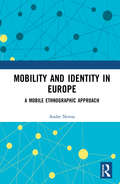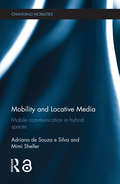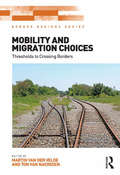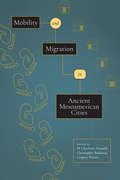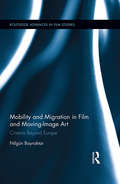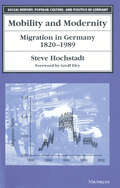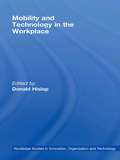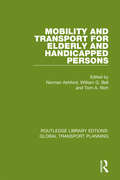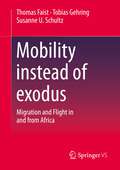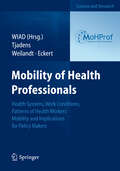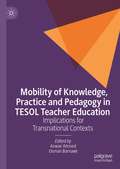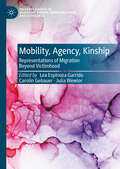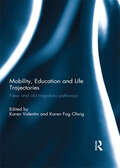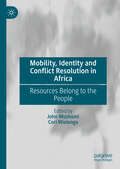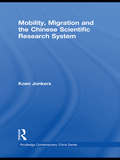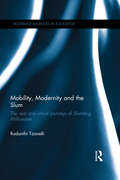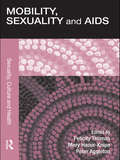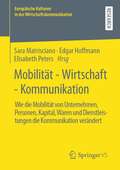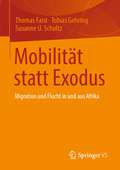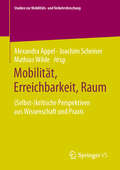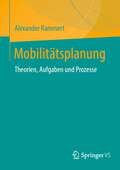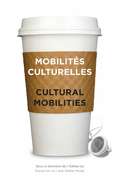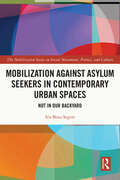- Table View
- List View
Mobility and Identity in Europe: A Mobile Ethnographic Approach
by Andre NovoaThis book demonstrates that mobility in Europe is not a synonym for European mobility, showing how certain mobile individuals are more likely to develop an explicitly European identity than others. Through a series of mobile ethnographic accounts with truck drivers, musicians and MEPs, the author lays out the complexities behind assumptions about mobility and European identity, providing a clear contrast between individuals for whom this process certainly is true and others who, in spite of their high levels of mobility, do not consider themselves European, or for whom the notion of being European is simply insignificant. Ultimately, as this book shows, the enactment of a European identity, through practices of mobility, has more to do with social class than with a mobile condition per se, with mobility in Europe being transformed into European mobility only when it empowers individuals, solidifying their elevated position in the social pyramid. An account of European identity and its connection to mobility and notions of class, Mobility and Identity in Europe also explores the ways in which mobile ethnography can be practised as a method and what conclusions can be drawn from it. As such, it will appeal to scholars and students of sociology, anthropology and geography.
Mobility and Locative Media: Mobile Communication in Hybrid Spaces (Changing Mobilities)
by Mimi Sheller Adriana de Souza e SilvaMobilities has become an important framework to understand and analyze contemporary social, spatial, economic and political practices. Especially as mobile media become seamlessly integrated into transportation networks, navigating urban spaces, and connecting with social networks while on the move, researchers need new approaches and methods to bring together mobilities with mobile communication and locative media. Mobile communication scholars have focused on cell phones, often ignoring broader connections to urban spaces, geography, and locational media. As a result, they emphasized virtual mobility and personalized communication as a way of disconnecting from place, location and publics. The growing pervasiveness of location-aware technology urges us to rethink the intersection among location, mobile technologies and mobility. Few studies have addressed the many transformations taking place in mobile sociality and in urban spatial processes through the appropriation of these technologies. Chapter 12 of this book is freely available as a downloadable Open Access PDF under a Creative Commons Attribution-Non Commercial-No Derivatives 3.0 license. https://s3-us-west-2.amazonaws.com/tandfbis/rt-files/docs/Open+Access+Chapters/9781138778139_oachapter12.pdf
Mobility and Migration Choices: Thresholds to Crossing Borders (Border Regions Series)
by Ton van Naerssen Martin van VeldeThe crossing of national state borders is one of the most-discussed issues of contemporary times and it poses many challenges for individual and collective identities. This concerns both short-distance mobility as well as long-distance migration. Choosing to move - or not - across international borders is a complex decision, involving both cognitive and emotional processes. This book tests the approach that three crucial thresholds need to be crossed before mobility occurs; the individual’s mindset about migrating, the choice of destination and perception of crossing borders to that location and the specific routes and spatial trajectories available to get there. Thus both borders and trajectories can act as thresholds to spatial moves. The threshold approach, with its focus on processes affecting whether, when and where to move, aims to understand the decision-making process in all its dimensions, in the hope that this will lead to a better understanding of the ways migrants conceive, perceive and undertake their transnational journeys. This book examines the three constitutive parts discerned in the cross-border mobility decision-making process: people, borders and trajectories and their interrelationships. Illustrated by a global range of case studies, it demonstrates that the relation between the three is not fixed but flexible and that decision-making contains aspects of belonging, instability, security and volatility affecting their mobility or immobility.
Mobility and Migration in Ancient Mesoamerican Cities
by Christopher Beekman M. Charlotte Arnauld Grégory PereiraMobility and Migration in Ancient Mesoamerican Cities is the first focused book-length discussion of migration in central Mexico, west Mexico and the Maya region, presenting case studies on population movement in and among Classic, Epiclassic, and Postclassic Mesoamerican societies and polities within the framework of urbanization and de-urbanization. Looking beyond the conceptual dichotomy of sedentism versus mobility, the contributors show that mobility and migration reveal a great deal about the formation, development, and decline of town- and city-based societies in the ancient world. In a series of data-rich chapters that address specific evidence for movement in their respective study areas, an international group of scholars assesses mobility through the isotopic and demographic analysis of human remains, stratigraphic identification of gaps in occupation, and local intensification of water capture in the Maya lowlands. Others examine migration through the integration of historic and archaeological evidence in Michoacán and Yucatán and by registering how daily life changed in response to the influx of new people in the Basin of Mexico. Offering a range of critical insights into the vital and under-studied role that mobility and migration played in complex agrarian societies, Mobility and Migration in Ancient Mesoamerican Cities will be of value to Mesoamericanist archaeologists, ethnohistorians, and bioarchaeologists and to any scholars working on complex societies. Contributors: Jaime J. Awe, Meggan Bullock, Sarah C. Clayton, Andrea Cucina, Véronique Darras, Nicholas P. Dunning, Mélanie Forné, Marion Forest, Carolyn Freiwald, Elizabeth Graham, Nancy Gonlin, Julie A. Hoggarth, Linda Howie, Elsa Jadot, Kristin V. Landau, Eva Lemonnier, Dominique Michelet, David Ortegón Zapata, Prudence M. Rice, Thelma N. Sierra Sosa, Michael P. Smyth, Vera Tiesler, Eric Weaver
Mobility and Migration in Film and Moving Image Art: Cinema Beyond Europe (Routledge Advances in Film Studies)
by Nilgun BayraktarMobility and Migration in Film and Moving Image Art explores cinematic and artistic representations of migration and mobility in Europe from the 1990s to today. Drawing on theories of migrant and diasporic cinema, moving-image art, and mobility studies, Bayraktar provides historically situated close readings of films, videos, and cinematic installations that concern migratory networks and infrastructures across Europe, the Middle East, and Africa. Probing the notion of Europe as a coherent entity and a borderless space, this interdisciplinary study investigates the ways in which European ideals of mobility and fluidity are deeply enmeshed with forced migration, illegalization, and xenophobia. With a specific focus on distinct forms of mobility such as labor migration, postcolonial migration, tourism, and refugee mobilities, Bayraktar studies the new counter-hegemonic imaginations invoked by the work of filmmakers such as Ayşe Polat, Fatih Akin, Michael Haneke, and Tony Gatlif as well as video essays and installations of artists such as Kutluğ Ataman, Ursula Biemann, Ergin Çavuşoğlu, Maria Iorio and Raphaël Cuomo. Challenging aesthetic as well as national, cultural, and political boundaries, the works central to this book envision Europe as a diverse, inclusive, and unfixed continent that is reimagined from many elsewheres well beyond its borders.
Mobility and Modernity: Migration in Germany, 1820-1989 (Social History, Popular Culture, And Politics In Germany)
by Steven Lawrence HochstadtMobility and Modernity uses voluminous German data on migrations over the past two centuries to demonstrate why conventional assumptions about the relationship between mobility and modernity must be revised. Thus far the changing total volume of migration has not been traced over a long period for any country. Unique migration registration statistics, both detailed and broadly geographical in coverage, allow the precise plotting of migration rates in Germany since 1820. Steve Hochstadt combines careful quantitative methods, easily understood numerical data, and social analysis based upon broad reading in German social history to show that current beliefs about the direction and timing of changes in German mobility, which have been based on late nineteenth-century anxieties about urbanization and industrialization, do not match the data. Migration rates in Germany rose continuously throughout the nineteenth century, and have fallen during the twentieth century. Mobility, Hochstadt argues, was not an unprecedented accompaniment to industrialization, but a traditional rural response to specific economic changes. Hochstadt's more precise analysis of urban in- and outmigration shows the mechanism of urbanization to have been the migration of families rather than the much greater, but also more circular, migration of single men and women. Hochstadt demonstrates the importance of examining historical behavior, powerfully justifying the methods of historical demography as a path to social understanding. The data and specific conclusions are German, but the methods and reinterpretaion of migration history have much wider application, both to other modern European nations and to currently developing countries. Those who study the modern social history of Europe, the mechanisms that formed urban working classes, and the methods of historical demography will be interested in Hochstadt's work.
Mobility and Technology in the Workplace
by Donald HislopThe contemporary period has witnessed the rapid evolution in a wide range of mobile technology. This book charts the profound implications these technological changes have for workers and business organizations. From an organizational point of view they have the potential to transform the nature of organizations, through allowing workers to be incr
Mobility and Territoriality: Social and Spatial Boundaries among Foragers, Fishers, Pastoralists and Peripatetics
by Michael J. CasimirTerritorial behaviour among various herders and hunter-gatherers has been discussed in earlier studies, but this is the first time that a comparison of these three types of mobile populations has been attempted. The original papers presented in this volume discuss the conditions and problems of securing access to resources among pastoralists, peripatetics, and hunting, gathering and fishing communities in Africa, Asia, Europe and the Middle East. A comprehensive introductory chapter places these empirical studies in a broader theoretical context of the behaviourial sciences.
Mobility and Transport for Elderly and Handicapped Persons (Routledge Library Edtions: Global Transport Planning #4)
by Norman Ashford, William G. Bell and Tom A. RichOriginally published in 1982 and contributed to by a range of international authors and experts in the field of transport accessibility, this volume discusses the position of urban and rural transport problems of the elderly and disabled in the UK, USA, Belgium, Canada, France, Germany, The Netherlands and Sweden. Based on research, policy analysis and documental field experience the volume also discusses advances made in relevant technology, major changes in public policy and innovative proposals for system development or change.
Mobility instead of exodus: Migration and Flight in and from Africa
by Thomas Faist Tobias Gehring Susanne U. SchultzAfrica is commonly regarded as a "continent on the move" in scholarly observation and mass media reportage. Movement is seen primarily in the direction of Europe. Yet the public debate is characterized by two misconceptions. The first is that high population growth in Africa would almost automatically trigger higher international migration to the neighbouring European continent. There is even talk of a "rush to Europe". The second frequently encountered misconception is that migration and flight in and from Africa is primarily a result of poverty, violent conflicts and environmental degradation. Both are misconceptions that cannot be reconciled with the facts at hand.
Mobility of Health Professionals
by Wissenschaftliches Institut Der Frits Tjadens Josef Eckert Caren WeilandtThis book on mobility of health professionals reviews, analyses and summarises published information and data as well as collected interview data from stake holders, including politicians, policy makers, health service managers and migrant health workers. It is based on the research carried out under the umbrella of the EU-funded project "Mobility of Health Professionals (MoHProf). The partners involved in the MoHProf project gathered evidence from 25 countries around basic questions and knowledge gaps relating to the international migration of health professionals, which involved an analysis of migration flows and evaluation of policies addressing migration. This book provides a comprehensive description and analysis of the mobility streams, the motives and driving forces behind them and the impact on and challenges for health systems and draws conclusions and provides recommendations for future strategic planning, monitoring and the management of mobility of health professionals as well as further research and policy development needs.
Mobility of Knowledge, Practice and Pedagogy in TESOL Teacher Education: Implications for Transnational Contexts
by Anwar Ahmed Osman BarnawiThis edited book brings together chapters from diverse geographical and educational contexts to examine the question of transnationalism in English Language teacher education. While the activities that connect people, institutions and cultural practices across the borders of nation-states have gained interest in fields such as applied linguistics, TESOL and migration studies in recent years, there has been little research so far into how transnationalism intersects with language teacher education, and how existing practices can be better integrated into teacher education programmes. The authors fill this gap by introducing and examining existing transnational practices - including cross-cultural settings, study abroad programmes and online teacher education - then offering multiple dialogues on mobility of knowledge, practice and pedagogy in teacher education. This book will be of interest to language teachers, teacher educators, and students and scholars of applied linguistics, cross-cultural studies, and migration studies.
Mobility, Agency, Kinship: Representations of Migration Beyond Victimhood (Palgrave Studies in Mediating Kinship, Representation, and Difference)
by Lea Espinoza Garrido Carolin Gebauer Julia WewiorThis volume offers new perspectives on the ways in which migrants use storytelling practices and kinship formations in order to navigate and modify spaces of sovereignty, and thus to re-write narratives portraying them as helpless and passive victims. It provides one of the first investigations that assembles multidisciplinary contributions to look beyond individual acts of migrant agency and toward the entanglements of individual and collective agency, formations of kinship structures, and feelings, expressions, and representations of community and (multiple) belonging(s). The contributions explore the interplay between agency, kinship, and migration from various fields, including sociology, psychology, philosophy, border studies, gender and queer studies, postcolonial studies, ecocriticism, film and media studies, and literary and cultural studies – with a special focus on interdisciplinary narrative theory. They address real and imagined assertions of migrant agency and kinship formations; draw on empirical research, interviews, and accounts of lived experiences; and analyze the role of narrative, media, and technologies in artistic, literary, and cinematic representations of migrant agency and kinship. By probing migrant identity discourses in different cultural and medial contexts, the contributions examine how narratives negotiate and challenge the unequal distribution of mobility, resources, and vulnerability that preconfigures many migrant lives; they also discuss narrative devices, storytelling techniques, and other representational strategies that migrants employ, as well as technologies that they draw on, to lay powerful claims on space and citizenship and to eschew established scripts of victimhood. As such, the volume addresses and embraces the tensions between vulnerability and agency that come to the fore when we try to understand the different ways in which migrants shape, and are shaped by, their (trans)local, material, economic, affective, social, cultural, and political realities.
Mobility, Education and Life Trajectories: New and old migratory pathways
by Karen Valentin and Karen Fog OlwigMigration for educational purposes, once the privilege of the upper class, has become a global mass phenomenon in recent years. This volume examines, within different cultural and historical contexts, the close relationship between migration, education, and social mobility. Adopting the perspective that education includes a broad range of formative experiences, the chapters explore different educational trajectories and the local, regional, and transnational relations in which they are embedded. Three key issues emerge from the analyses: firstly, the central role of temporal aspects in terms of both the overall historical conditions and the specific biographical circumstances shaping educational opportunities; secondly, the complex agendas informing individuals’ migration and the adjustment of these agendas in the light of the vagaries of migrant life; and thirdly, the importance of migrants’ self-perception as ‘educated persons’, and the invention of new identities, and the maintaining of old identities that this involves. This book was originally published as a special issue of Identities: Global Studies in Culture and Power.
Mobility, Identity and Conflict Resolution in Africa: Resources Belong to the People
by Cori Wielenga John MushomiThis volume examines land and resource contestations in the East African Albertine region, where Uganda, the Democratic Republic of Congo, Rwanda, Burundi and Tanzania intersect. It is one of the most biodiverse regions on the continent, and became highly contested when Uganda discovered oil there in 2006. The resource contestation in this region has resulted in ongoing conflict, and has defined and re-defined identity and citizenship. Contributors of this volume succinctly bring out the major forces that have been responsible for resource contestations and conflicts together with an emphasis on the existing mechanisms for peaceful co-existence, particularly in relation to alternative dispute resolution mechanisms within indigenous knowledge systems.
Mobility, Migration and the Chinese Scientific Research System (Routledge Contemporary China Series)
by Koen JonkersChina’s rise is having a large impact on the global science system. The internalisation of this system in the past two decades would not have been possible without the outbound and especially the return flows of overseas Chinese scientists. This book explores their impact combining macro-level institutional and statistical analysis with an account of how the research culture has changed at the operational level. The theoretical framework used departs from the human capital approach, by building on literature from migration studies and evolutionary theories of the science system. It presents the results of an innovative mix of quantitative and qualitative methodological approaches. Overseas Chinese scientists and returnees are shown to have played an important role in shaping the internal development of the Chinese research system, as well as its relationship with research systems in Western Europe and North America. Now that the situation is improving, return has become an increasingly interesting option for expatriate researchers. This development may result in a virtuous cycle. Based on extensive and original empirical research Mobility, Migration and the Chinese Scientific Research System will be of interest to scholars and postgraduate students of research systems in general and the Chinese research and innovation system in particular.
Mobility, Modernity and the Slum: The Real and Virtual Journeys of 'Slumdog Millionaire' (Routledge Advances in Sociology)
by Rodanthi TzanelliOnly virtuous humans are supposed to move in time to meet their happy destiny or karma. The tale of Jamal in Slumdog Millionaire is such a case of serendipitous mobility towards riches and love – a ‘journey’ in which good heroes and urban communities respecting solidarity are successfully modernised. Unsurprisingly, the film became tangled in many controversies around India’s destiny in the world: the film inserted Mumbai into various financial, political and artistic scenes, increased tourism in its filmed slums, and brought about charity projects in which celebrities and tourist businesses were involved. Slumdog Millionaire served as a global example of a ‘developing country’s’ uneven but unique modernisation. This book examines such mobilities of ideas, art, tourism and activism together. In doing so, it reveals the significance of Mumbai as a post-colonial city in discussions of modernity – a form of mobile adaptation to new world realities. Tzanelli examines the various agents involved in controversies through multiple virtual and real journeys to India’s colonial history and present social complexity, with a view to actualise a post-colonial future, a ‘destiny’ as the country’s serendipitous destination. Addressed to interdisciplinary audiences, the book will be a useful text for students and scholars of globalisation, mobility, tourism, media and social movement theory.
Mobility, Sexuality and AIDS (Sexuality, Culture and Health)
by Peter Aggleton Felicity Thomas Mary Haour-KnipeOver the past two decades, population mobility has intensified and become more diverse, raising important questions concerning the health and well-being of people who are mobile as well as communities of origin and destination. Ongoing concerns have been voiced about possible links between mobility and HIV, with calls being made to contain or control migrant populations, and debate linking HIV with issues of global security and surveillance being fuelled. This volume challenges common assumptions about mobility, HIV and AIDS. A series of interlinked chapters prepared by international experts explores the experiences of people who are mobile as they relate to sexuality and to HIV susceptibility and impact. The various chapters discuss the factors that contribute to the vulnerability of different mobile groups but also examine the ways in which agency, resilience and adaptation shape lived experience and help people protect themselves throughout the mobility process. Looking at diverse forms of migration and mobility – covering flight from conflict, poverty and exploitation, through labour migration to ‘sex tourism’ – the book reports on research findings from around the world, including the USA, the UK, sub-Saharan Africa, Australia, Central America and China. Mobility, Sexuality and AIDS recognises the complex relationships between individual circumstances, population mobility and community and state response. It is invaluable reading for policy makers, students and practitioners working in the fields of migration, development studies, anthropology, sociology, geography and public health.
Mobilität - Wirtschaft - Kommunikation: Wie die Mobilität von Unternehmen, Personen, Kapital, Waren und Dienstleistungen die Kommunikation verändert (Europäische Kulturen in der Wirtschaftskommunikation #33)
by Sara Matrisciano Edgar Hoffmann Elisabeth PetersMobilität ist ein Hauptcharakteristikum des Wirtschaftslebens: Unternehmen stehen nicht nur vor sprachpolitischen Herausforderungen, sondern müssen sich auch mit dem Spannungsfeld zwischen lokaler Realität und Internationalisierungsprozessen auseinandersetzen und sich dabei der Frage stellen, wie sie in einer von Mobilität getriebenen Welt ihre Kunden, Investoren und andere Stakeholder (besser) erreichen können. Die physische und virtuelle Mobilität von Unternehmen, Personen, Kapital, Waren und Dienstleistungen führt zu neuen Markt- und Kommunikationsbedingungen, in denen die Mobilität mitunter auch selbst in Form von Mobilitätslösungen als Produkt fungiert. Sie wirkt sich unmittelbar auf den Inhalt und die Art der Wirtschaftskommunikation aus, die dieser interdisziplinär ausgerichtete Band aus den Blickwinkeln von Theoretikern und Praktikern ausleuchtet.
Mobilität statt Exodus: Migration und Flucht in und aus Afrika
by Thomas Faist Tobias Gehring Susanne U. SchultzGemeinhin gilt Afrika in der wissenschaftlichen Betrachtung und in den Reportagen der Massenmedien als „Kontinent in Bewegung" – Bewegung vor allem in Richtung Europa. Dabei ist die öffentliche Diskussion von zwei Fehlannahmen geprägt. Die erste davon besagt, dass ein hohes Bevölkerungswachstum in Afrika quasi automatisch höhere internationale Migration in den angrenzenden europäischen Kontinent auslösen würde. Es ist gar von einem „Ansturm auf Europa" die Rede. Die zweite häufig anzutreffende Fehlannahme geht davon aus, dass Migration und Flucht in und aus Afrika vorwiegend ein Resultat von Armut, gewaltsamen Konflikten und Umweltzerstörung sei. Beides sind Fehlannahmen, die sich mit den vorliegenden Fakten nicht vereinbaren lassen. Diese Fakten sind Gegenstand des vorliegenden Bandes.
Mobilität und Teilhabe – Begleitdienste im öffentlichen Personennahverkehr: Erfahrungen aus einem sozio-technischen Forschungsprojekt
by Daniel Bieber Sascha Roder Jan Alexandersson Jana Rößler Kathleen SchwarzDas Mobilitätsprojekt „mobisaar“ verbessert die Teilhabe von mobilitätseingeschränkten Menschen und Menschen mit Behinderungen durch den Einsatz von Lots*innen und mit Technikunterstützung durch Apps. Das in vier saarländischen Landkreisen erfolgreich umgesetzte BMBF-Projekt wird nach 5 Jahren Laufzeit 2020 finalisiert und bietet einen guten Einblick in die Konzepte, Strukturen und Schulungsideen des kostenfreien Begleitdienstes im kleinsten Flächenland Deutschlands sowie dessen Auswirkungen auf den ÖPNV.
Mobilität, Erreichbarkeit, Raum: (Selbst-)kritische Perspektiven aus Wissenschaft und Praxis (Studien zur Mobilitäts- und Verkehrsforschung)
by Joachim Scheiner Mathias Wilde Alexandra AppelDer Sammelband fasst wichtige Themen und Entwicklungen der Mobilitäts- und Verkehrsforschung der letzten Jahre zusammen. Die Beiträge gehen auf das Instrumentarium empirischer Forschung ein und erläutern deren Einsatzbereiche anhand konkreter Anwendungsfälle. Genauso zeigt der Sammelband jene Perspektiven auf, mit denen die Planungspraxis der (Um-)Gestaltung der Verkehrssysteme eine Form geben kann, um nachhaltigere Mobilität zu fördern. Damit richtet er sich sowohl an eine Leserschaft, die sich mit den wissenschaftlichen Grundlagen der Mobilitäts- und Verkehrsforschung befasst, als auch an eine Leserschaft, die an wissenschaftlich fundierten Maßnahmen zur nachhaltigen Umgestaltung der Verkehrssysteme interessiert ist.
Mobilitätsplanung: Theorien, Aufgaben und Prozesse
by Alexander RammertDieses Buch umfasst die wesentlichen Grundlagen einer praxisorientierten Mobilitätsplanung. Im Gegensatz zur Verkehrsplanung fokussiert sich die Mobilitätsplanung auf den Menschen als zentrale Figur der Verkehrsentwicklung und entwirft daraus neue Perspektiven für die Planung. Mobilitätsplanung löst damit die Abhängigkeit vom technischen Artefakt des Verkehrs und zielt stattdessen darauf ab, direkt die Möglichkeiten der Menschen zu verstehen und zu beeinflussen. Das Buch richtet sich somit an alle Akteure, welche die Mobilität der Menschen in unterschiedlicher Weise beeinflussen. Klassischerweise gehören hierzu alle Ebenen der Planungspraxis, von Ministerien bis hin zu kommunalen Verwaltungen und Planungsbüros. Aber auch politisch Entscheidungstragende, Unternehmen und zivilgesellschaftliche Akteure gehören zu den Adressaten dieses Buches, da sie maßgeblich an der zukünftigen Entwicklung von Mobilität und Verkehr mitwirken.
Mobilités culturelles - Cultural Mobilities (Transferts culturels)
by Pascal Gin et/and Walter MoserLa mobilité – la capacité à se déplacer ou à être déplacé – est un élément si omniprésent dans la vie moderne qu’elle est tenue pour acquise, presque imperceptible en raison de sa constante présence. Dans Mobilités culturelles – Cultural Mobilities, des chercheurs du Canada et du Brésil, écrivant en anglais et en français, s’interrogent sur l’impact et l’influence qu’a la mobilité sur les dynamiques culturelles au sein de leurs deux pays et entre eux. Explorant le mouvement – des gens, des idées et des créations culturelles – et les processus qui affectent ce mouvement, ils apportent de nouvelles perspectives sur la manière dont la mobilité structure les conditions culturelles contemporaines. Intrinsèquement interdisciplinaire, le volume s’appuie sur des contributions provenant entre autres des domaines de la géographie urbaine, des arts visuels, du cinéma, de la littérature, de la danse et du journalisme, soulignant la mobilité comme un domaine important de la recherche universitaire. Aussi intrinsèquement interculturel, il utilise une approche comparative Sud–Nord qui révèle les points communs et les différences entre les contextes canadien et brésilien. Mobilités culturelles – Cultural Mobilities propose une méthode pour l’étude de la mobilité en tant que force culturelle dans la société contemporaine.
Mobilization against Asylum Seekers in Contemporary Urban Spaces: Not in Our Backyard (The Mobilization Series on Social Movements, Protest, and Culture)
by Iris Beau SegersThis book investigates the issue of local mobilization against asylum seekers in urban areas, which are often disproportionally affected by complex issues related to immigration and integration, as well as socio-economic development and growing inequalities. Based on ethnographic research in the city of Rotterdam, it explores the conditions under which mobilization against the establishment of an asylum seekers’ centre emerged, offering a combined analysis of interviews, social media, and mainstream media to demonstrate the key role played by storytelling in the development of opposition to the arrival of asylum seekers. Presenting a theoretical model of anti-immigration mobilization that connects the social importance of storytelling to broader socio-political developments and conditions, this volume will appeal to scholars of sociology, anthropology, and politics with interests in migration, social movements, and mobilization around contentious issues.
